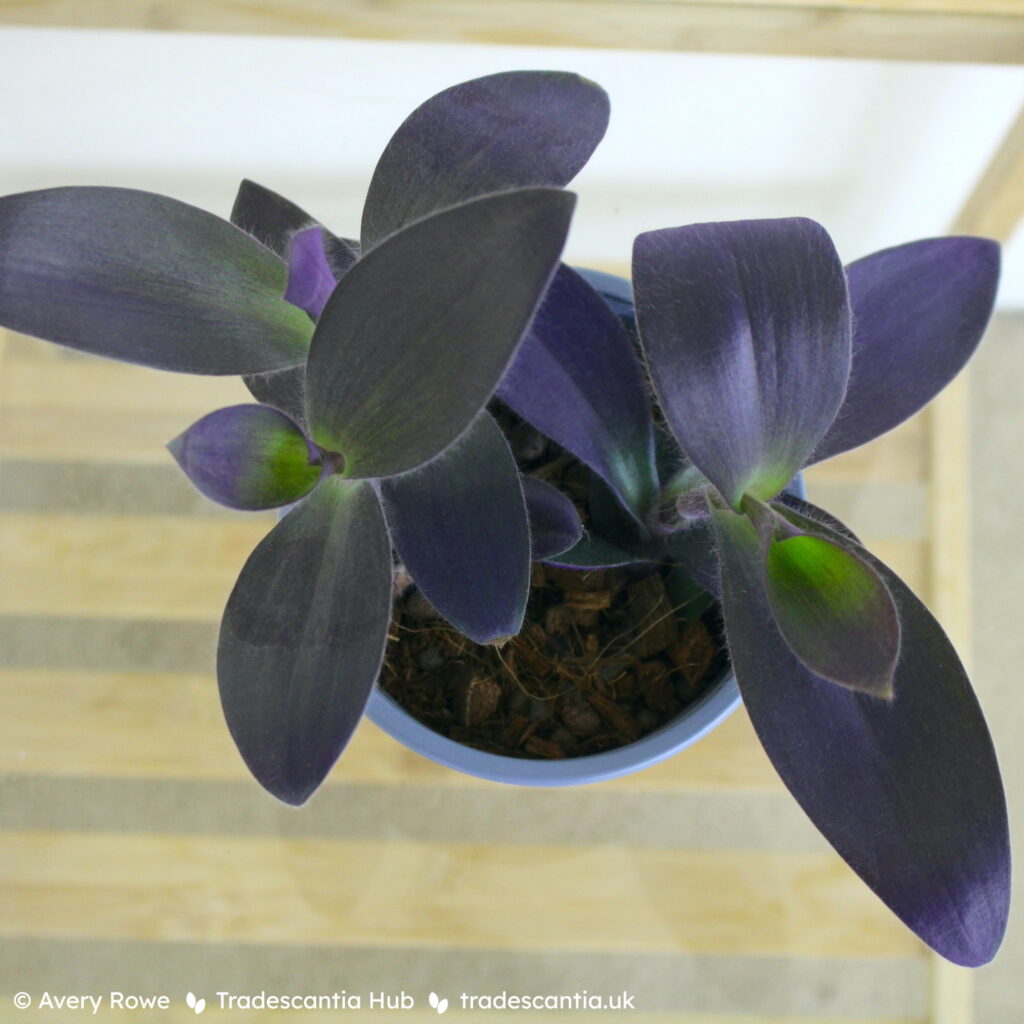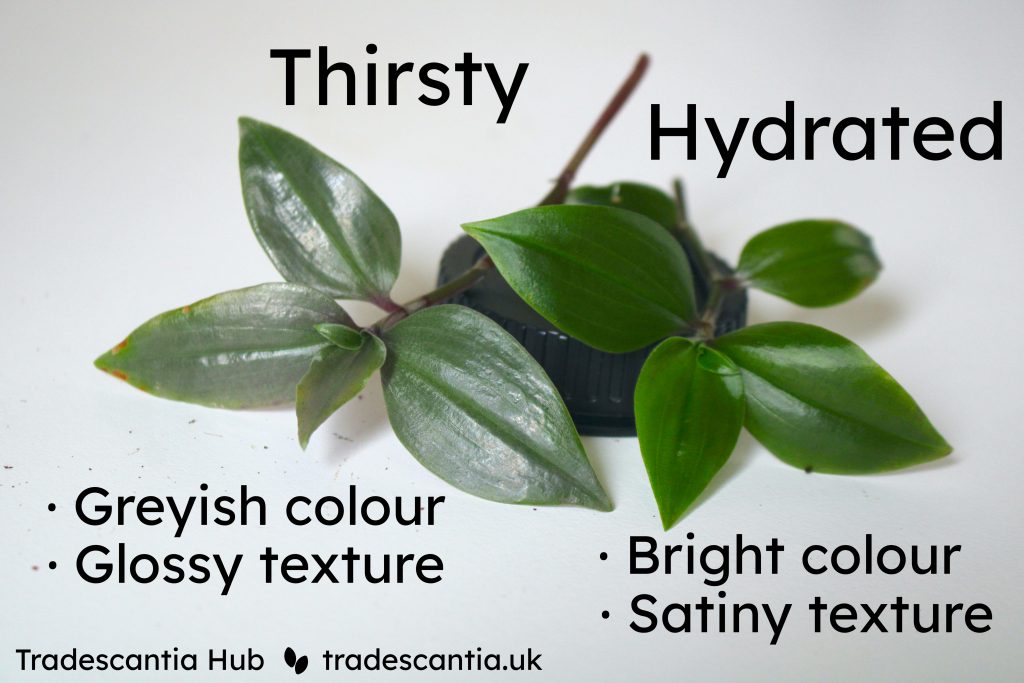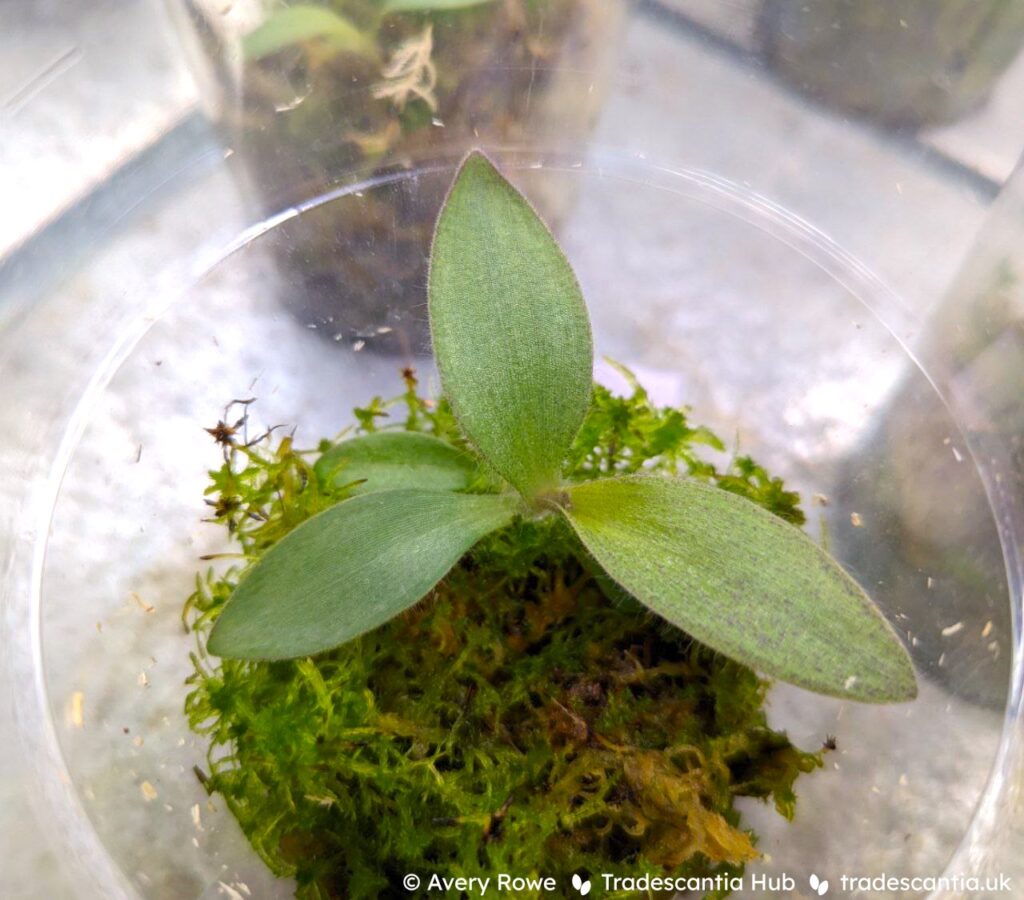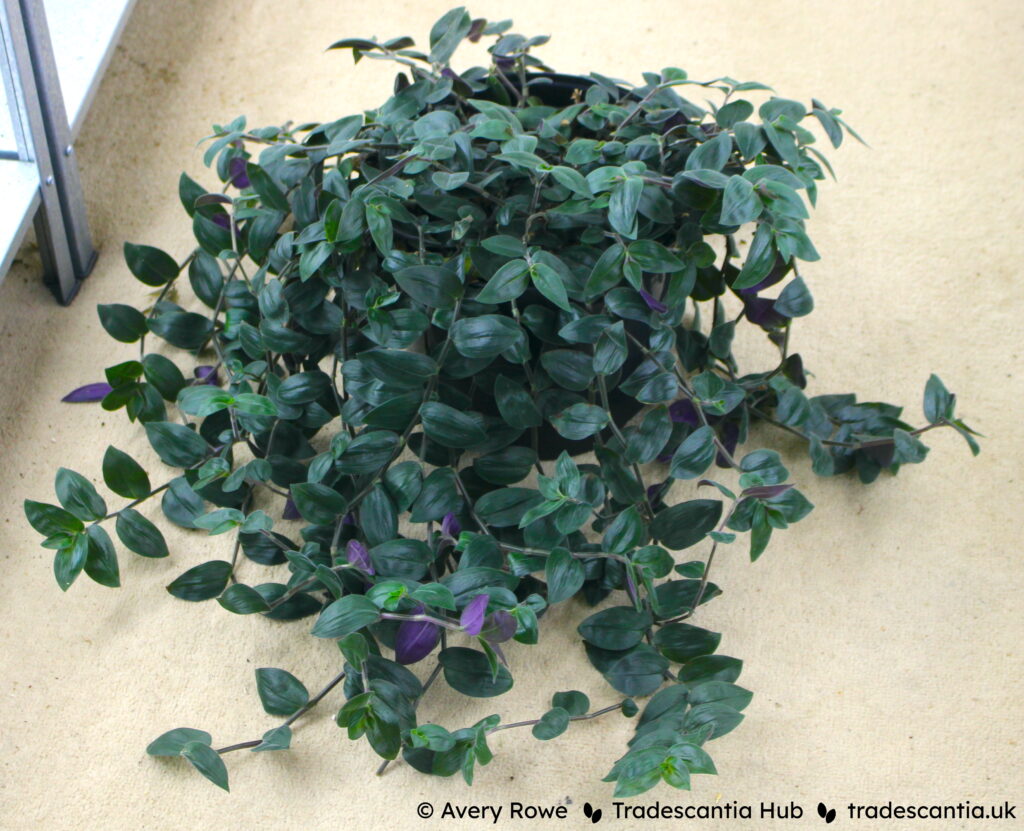Skip to: Light and colour // Water // Soil and feeding // Temperatures // Potting and pruning // Propagating // Pests
Care is broadly the same for keeping most tropical Tradescantia and other Commelinaceae as houseplants. This guide is a summary of how to care for them in general, and will also include some specific tips for common groups within the family. You can also read these articles about how I specifically care for my collection: indoors and outdoors.
Light and colour
This requirement is fairly variable across the family, but most species can tolerate quite a range of light levels. Overall when growing as houseplants, it’s almost impossible to provide too much light – even the sunniest place indoors is more like shade outside.
Many species and cultivars develop anthocyanins, which are red or purple pigments that act as sun protection for the plant. They combine with the underlying chlorophyll (green pigment) of the leaf to make a huge range of colours. If the underlying leaf is dark green, anthocyanins can make it rich purple (like Tradescantia pallida ‘Purpurea’ or Tradescantia zebrina ‘Violet Hill’). If the leaf has variegated white or yellow parts, anthocyanins can turn those areas bright pink (like Tradescantia mundula ‘Lisa’ or Tradescantia ‘Maiden’s Blush’).
The plant changes the amount of anthocyanins in the leaves in response to the amount of light it needs to protect itself from. This means that if the plant is in higher light, it will show its red or purple colours more strongly than in lower light. So if you’re growing any cultivar which has these colours, you can influence them by giving it different light levels. If you want the plant to show brighter or stronger pink and purple colours, give it higher light. If you want it to be more green or yellow, give it less light. With some experience, you can even use these plants as indicators of the light level, by watching how their colour changes in different locations.
If a plant has too much light to cope with, its growth will generally slow down and become stunted. The leaves might become scorched with brown or crispy spots, and start to curl up or wilt. If a plant doesn’t have enough light, its growth will become etiolated (“leggy”) – the stems grow very long and thin with small leaves.
In general, plain-green creeping plants are the most likely to tolerate low light without major problems. Cultivars with delicate white- or pink-variegated leaves are at the most risk of scorching in direct light, although they can still adapt to it given plenty of time. Of the popular cultivated types, species from Tradescantia subgenus Setcreasea (like T. pallida and T. sillamontana) tend to be the most demanding of direct sun, and will become very etiolated and pale in anything less than the brightest light.

Water
People are often surprised to learn that most Commelinaceae species are somewhat succulent. They have the ability to store water in their stems and leaves, which makes them quite tolerant of drought. But they are not quite as prone to rot as more extremely adapted succulents like cacti. In general when growing in containers of regular potting mix, you should let the soil mostly dry out in between thorough waterings. If you stick your finger into the soil and it still feels moist or sticky, it doesn’t need watering yet!
Because they are drought tolerant, they don’t show very obvious signs when they’re thirsty. But there are subtle hints to look out for. The leaf surface becomes more smooth and shiny, the leaves themselves become slightly thinner and papery, and colours become dull and greyish. This picture shows a comparison of Tradescantia mundula ‘Green Hill’ when thirsty and when well-hydrated.

They won’t show any signs at all if they’re too well-hydrated. It won’t be apparent until the roots have rotted and the plant starts to die. That’s why if you’re in any doubt at all, it’s much safer to water less often rather than more. If you’re not sure whether the plant needs water, just wait a couple more days! Eventually it will start to show signs that you can recognise, and then it will recover very quickly once it’s rehydrated.
In general, plants with thicker, tougher-feeling leaves are the most tolerant of drought – particularly if the leaves are also covered in hair. Tradescantia sillamontana with its “cobweb” furry leaves can be treated pretty much like a succulent. Whereas plants with thinner or papery leaves like Tradescantia fluminensis need water a little more often.
Soil and feeding
Commelinaceae are generally very unfussy when it comes to what substrate they grow in. They don’t need anything fancy, and will usually grow just fine in whatever regular potting soil or houseplant mix you have on-hand. They’ll also grow well in a more airy succulent or cactus mix. Regardless of the type of soil you use, the important thing is to water them according to when that soil dries out. Some mixes will dry quicker or slower, but as long as you adapt to it, almost anything can work fine.
The need for extra fertiliser will depend on the potting mix a plant is in – if it contains slow-release nutrients then they won’t need supplemental nutrients unless they’ve been in the same soil for over a year. If the potting mix doesn’t have any nutrients, or only comes with a few weeks’ or months’ supply, then they’ll need periodic feeding with any standard fertiliser just like other container plants. A hungry plant will slow down its growth, and leaves will start to become faded and yellow.
They can also be grown in more unusual ways, like in sphagnum moss, a hydroponic mineral substrate, or even pure water. Although these methods can work fine, I wouldn’t recommend them for long-term use by a beginner. They all require careful micromanaging like providing just the right amount of nutrients, and allowing just the right wet/dry cycle to keep the roots healthy. But if you enjoy experimenting and don’t mind some finicky work, it can be a very interesting way to grow!

Temperatures
It’s very difficult to give conclusive recommendations about temperature tolerance, because there’s so little information or research to refer to. My best advice is simply to try things out with your own plants in your own growing conditions, and find out what works and what doesn’t.
In general the common houseplant species are native to tropical or subtropical locations, which means they prefer warm temperatures. There’s no real risk of temperatures being too hot for them – any room or greenhouse which a person can safely walk into is likely to be within the heat tolerance of tropical plants!
Their low temperature threshold is much more variable between different species. Most tropical Commelinaceae will significantly slow down their growth when temperatures are below 10-15ºC. Below these temperatures, it’s best to keep them very dry and just allow them to be dormant. Like other succulents, if they are cool and also wet, they are more likely to rot.
I’ve found that all the plants I’ve grown so far have been able to withstand getting all the way down to 0ºC without any actual damage. Once temperatures get below freezing, most species will start to lose leaves and die back. But even then, they can sometimes miraculously regrow from the roots once things warm up again.
Potting and pruning
Although their roots grow and spread very quickly, Commelinaceae don’t generally suffer much from lack of root space. The main problem rootbound plants have is that there isn’t enough soil to hold onto water for a long time, so they become easily dehydrated. But semi-succulents are great at storing water, so that doesn’t cause much of an issue.
Different species have different growth habits, but they are almost universally creeping plants to one degree or another. In the wild their stems spread along the ground, rooting as they go. Transfer that growth habit to a container, and you have a plant which trails out of its pot with hanging stems. Some people prop up long stems with canes or trellis, but they are not naturally climbing plants so this is really creating an artificial state – without support any long parts will eventually lean over and start to trail.
Because they have developed to crawl along the floor, they aren’t adapted well to having stems that grow a very long way from the roots – either hanging out of a pot or being propped upwards. Long parts will progressively lose their lower leaves, which people often find unattractive. The stems are also very brittle and ultimately they are likely to break or fall off once they get long. This isn’t a sign of any problem, it’s simply a natural response for a plant which wants to maintain constant contact with the ground and grow roots all the way along.
To slow down this progression of bare lower stems and broken pieces, prune the growing stems as often as possible – the plant will immediately start making new branches. Once a plant becomes very old and straggly, it’s generally easier to “restart” than to try to repot. Cut the healthy ends from all the stems, then discard the whole base and rootball, and pot the cuttings back into fresh soil (or propagate them in any other way).

Propagating
Commelianceae plants – especially tradescantias – are almost legendarily easy to propagate from cuttings. A short piece of stem with a single leaf has the ability to grow roots and form a whole new plant, just by laying on bare ground. In fact, this is why their stems are so brittle – they’ve evolved so that pieces will break off at the slightest touch and root wherever they land! In some warm locations, tradescantias are considered invasive because of how easily they spread.
Everyone has their own preferred method for propagating. Some people like to put cuttings in water to watch the roots grow before potting them up. Other people lay cut stems flat on the surface of soil to mimic their wild behaviour. Or poke a vertical hole into the soil and push the bottom part of the stem down into it. The truth is, it’s difficult to go wrong – they practically propagate themselves!
Because it’s so easy to propagate cuttings in soil, it can be done alongside pruning in the same process. Cut the ends of longer stems, and stick them straight back into the same pot, for a double-action approach to making a more bushy plant.
For delicate or struggling cuttings, increased humidity will improve the success rate. Put a clear bag over the top of the pot, or put the entire pot inside an airtight container like a plastic box. This will reduce the amount of water the plant loses through its leaves, so it doesn’t have a constant battle with dehydration before it’s formed enough roots to drink with.
Some cultivars will flower randomly when they’re healthy, others stubbornly refuse to flower no matter what. Each flower opens for only a few hours or a day, but usually a succession of flowers will form in the same place over weeks or months. Flowering doesn’t have any effect on the plant’s overall health but it tends to slow down stem growth. It’s fine to leave the plant to its own devices, or remove the flower stalks if you prefer. Growing from seed is not generally the easiest or most efficient method of propagation, but it can be very interesting if you like a challenge.
Pests
When grown indoors, Commelinaceae can be susceptible to all the usual houseplant or greenhouse pests. Tradescantias seem to be particularly attractive to thrips, which hide in the folds of new leaves and can do a surprising amount of damage before adult bugs are ever spotted. For any indoor pests, the usual steps of removing visible bugs, spraying with natural oil or soap treatments, and adding biological controls are often all that’s needed. Chemical pesticides should only ever be used as a last resort for serious infestations.
Aphids are fairly common on plants growing outside, but they rarely seem to become severe enough to cause any real damage. It’s generally best to take an even more hands-off approach for plants growing outside. Most of the time natural predators and environmental conditions will prevent any infestation from getting out of control. And it’s important to avoid any chemicals which might harm pollinators or other wildlife that encounter the plants outside.
